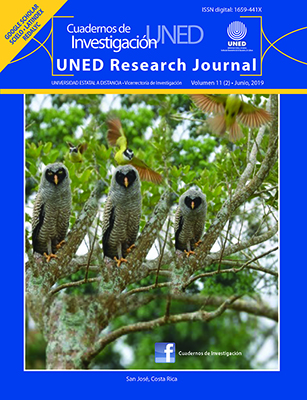Culicoides (Diptera: Ceratopogonidae) from Ceará State, northeastern Brazil: Diversity, new records and bionomic approaches.
DOI:
https://doi.org/10.22458/urj.v11i2.2149Keywords:
biting midges, insect vectors, biodiversity, bionomy.Abstract
Introduction: little is known about the biodiversity of the genus Culicoides and the possible presence of vector species in Ceará State, Brazil. Objective: to improve the knowledge about the biodiversity and possible vectors presence in northeastern Brazil. Methods: with CDC light traps we surveyed Culicoides species in 18 municipalities from six mesoregions of Ceará State. Results: we collected 1 453 specimens (12 species). Culicoides guyanensis was the most abundant species, with 75,84% of the collected specimens. Culicoides venezuelensis is well distributed and is found in five Mesoregions. We recorded five species for the first time from Ceará State and seven from the surveyed municipalities; the presence of species with sanitary importance is discussed. Conclusion: with the addition of new species records, there are now 12 species known from Ceará State. The presence of species with medical and/or veterinary importance in the studied Mesoregions is indicative of the need of epidemiological surveillance in this state.
References
Aitken, T.H.G., Wirth, W.W., Williams, R.W., Davies, J.B., & Tikasingh, E.S. (1975). A review of the bloodsucking midges of Trinidad and Tobago, West Indies (Diptera: Ceratopogonidae). Journal of Entomology (B), 44(2), 101-144. DOI: 10.1111/j.1365-3113.1975.tb00007.x
Barbosa, F.A.S. (1953). Novos subsídios para o conhecimento dos Culicoides neotrópicos (Diptera: Heleidae). Publicações Avulsas do Instituto Aggeu Magalhães, 2(3), 11-42.
Borkent, A. (2016). The Subgeneric Classification of Species of Culicoides - thoughts and a warning. Retrieved from
http://wwx.inhs.illinois.edu/files/5014/6532/8290/CulicoidesSubgenera.pdf
Borkent, A., & Spinelli, G.R. (2007). Neotropical Ceratopogonidae (Diptera: Insecta). In J. Adis, J. R. Arias, G. Rueda-Delgado, & K. M. Wnatzen (Eds.), Aquatic Biodiversity in Latin America (ABLA) 4 (pp. 1-198). Sofia-Moscow: Pensoft.
Castellón, E.G., & Felippe-Bauer, M.L. (2015). Classificação e distribuição das espécies de Culicoides (Diptera: Ceratopogonidae) na Amazônia Brasileira ou Amazônia Legal. In E. G. Castellón & R. S. Veras (Eds.), Maruins (Culicoides: Ceratopogonidae) na Amazônia Brasileira (pp. 29-73). Manaus: Editora INPA.
Diaz, F., Ronderos, M.M., & Spinelli, G.R. (2005). The immatures of Neotropical species Culicoides venezuelensis Ortiz & Mirsa (Diptera: Ceratopogonidae). Transactions of the American Entomological Society, 131(3/4), 375-385.
Felippe-Bauer, M.L., & Sternheim, U.S. (2008). Culicoides paraensis (Diptera: Ceratopogonidae) infestations in cities of the Itapocú River Valley, southern Brazil. Entomological News, 119(2), 185-192. DOI: 10.3157/0013-872X(2008)119[185:CPDCII]2.0.CO;2
Forattini, O.P. (1957). Culicoides da Região Neotropical (Diptera, Ceratopogonidae). Arquivos da Faculdade de Higiene e Saúde Pública da Universidade de São Paulo, 11, 159-526. DOI: 10.11606/issn.2358-792X.v11i2p161-526
Forattini, O. P., Rabello, E. X., & Pattoli, D. (1957). A brief note on breeding places of Culicoides in São Vicente, Brazil. Mosquito News, 17, 312-313.
Forattini, O. P., Rabello, E. X., & Pattoli, D. (1958). Culicoides da região neotropical (Diptera: Ceratopogonidae). II - Observações sobre biologia sobre condições naturais. Arquivos da Faculdade de Higiene e Saúde Pública da Universidade de São Paulo, 12, 1-52. DOI: 10.11606/issn.2358-792X.v12i1p1-52
Mellor, P. S. (2004). Infection of the vectors and bluetongue epidemiology in Europe. Epidemiology and vectors 40(3), 167-174.
Pinheiro, R. R., Chagas, A.C.S., Andrioli, A., & Alves, F. F. (2003). Viroses de pequenos ruminantes. Embrapa Caprinos, 46,1-30.
Ronderos, M.M., Marino, P. I., Díaz, F., & Estévez, A. L. (2011). Biting midges (Diptera: Ceratopogonidae) from Martín García Island, Argentina. Revista de Biología Tropical, 59(3), 1183-1194.
Santarém, M.C.A., Farias, E.S., & Felippe-Bauer, M.L. (2015). Culicoides castelloni sp. nov. from the Brazilian Amazon Region with a revision of the reticulatus species group (Diptera, Ceratopogonidae). Anais da Academia Brasileira de Ciências, 87(2), 955-972. DOI: 10.1590/0001-3765201520140517
Santarém, M. C. A., & Felippe-Bauer, M. L. (2018). Brazilian species of biting midges. Retrieved from: https://portal.fiocruz.br/sites/portal.fiocruz.br/files/documentos/brazilian_species_of_biting_midges_2018_.pdf
Vasconcelos, H.B., Azevedo, R.S.S., Casseb, S.M., Nunes-Neto, J.P., Chiang, J.O., Cantuária, P.C., ... Vasconcelos, P.F.C. (2009). Oropouche fever epidemics in Northern Brazil: Epidemiology and molecular characterization of isolates. Journal of Clinical Virology, 44, 129-133. DOI: 10.1016/j.jcv.2008.11.006
Vasconcelos, H.B., Nunes, M.R., Casseb, L.M.N., Carvalho, V.L., Silva, E.V.P., Silva, M., & Vasconcelos, P.F.C. (2011). Molecular Epidemiology of Oropouche Virus, Brazil. Emerging Infectious Deseases, 17(5), 800-806. DOI: 10.3201/eid1705.101333
Williams, R.W. (1964). Observations on Habitats of Culicoides Larvae in Trinidad, W. I. (Diptera: Ceratopogonidae). Annals of the Entomological Society of America, 57, 462-466.
Wirth, W.W., Dyce, A.L., & Spinelli, G.R. (1988). An Atlas of wing photographs, with a summary of the numerical characters of the Neotropical species of Culicoides (Diptera: Ceratopogonidae). Contributions of the American Entomological Institute, 25(1), 1-72.
Wirth, W.W., & Marston, N. (1968). A method for mounting small insects on microscope slides in Canada Balsam. Annals of the Entomological Society of America, 61, 783-784. DOI: 10.1093/aesa/61.3.783
Published
How to Cite
Issue
Section
License
Note: This abstract contains an incorrect copyright due to technical issues. Authors who publish with this journal agree to the following terms: Authors retain copyright and grant the journal right of first publication with the work simultaneously licensed under a Creative Commons Attribution License that allows others to share the work with an acknowledgement of the work's authorship and initial publication in this journal
All journal contents are freely available through a CC BY 4.0 license.
CC BY 4.0 is a Creative Commons: you can copy, modify, distribute, and perform, even for commercial reasons, without asking permission, if you give appropriate credit.
Contents can be reproduced if the source and copyright are acknowledged according to the Open Access license CC BY 4.0. Self-storage in preprint servers and repositories is allowed for all versions. We encourage authors to publish raw data and data logs in public repositories and to include the links with all drafts so that reviewers and readers can consult them at any time.
The journal is financed by public funds via Universidad Estatal a Distancia and editorial independence and ethical compliance are guaranteed by the Board of Editors, UNED. We do not publish paid ads or receive funds from companies.
